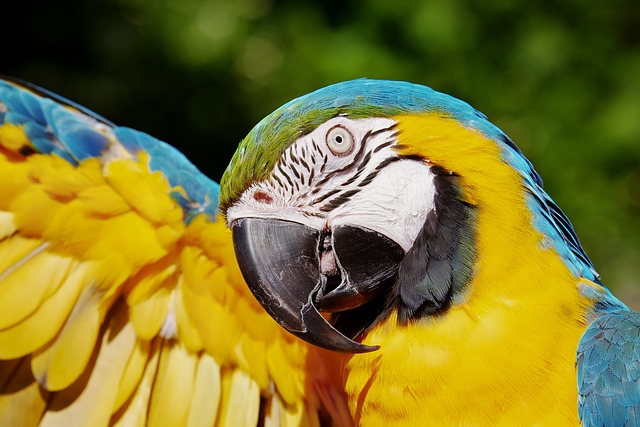The yellow macaw, also known as the blue-and-yellow macaw (Ara ararauna), is one of the most strikingly beautiful and well-known species of parrots in the world. Below is a comprehensive description of the yellow macaw, covering its appearance, habitat, behavior, diet, and conservation status:

Physical Appearance
- Size: Adult yellow macaws are large parrots, typically measuring between 30 to 34 inches (76 to 86 cm) in length, including their long tail feathers. Their wingspan can reach up to 41 to 45 inches (104 to 114 cm).
- Weight: They generally weigh around 2 to 3 pounds (0.9 to 1.4 kg).
- Coloration:
- The body features a vibrant yellow plumage, especially on the chest and underparts.
- The upperparts, including the wings and back, are a rich turquoise-blue.
- The crown of the head often has a slight greenish tinge.
- The face is bare and white with black feather lines forming distinctive streaks.
- The large beak is black, and the legs are dark gray.
- Their eyes are pale yellow, giving them a sharp, piercing gaze.
- Sexual Dimorphism: Males and females look nearly identical, making it difficult to distinguish between them without genetic testing.
Habitat and Distribution
- Native Range: Yellow macaws are native to Central and South America, ranging from Panama in Central America to Brazil, Bolivia, and Paraguay in South America.
- Preferred Habitat:
- They thrive in tropical rainforests, especially near rivers and wetlands.
- They are also found in open woodlands, savannas, and palm groves.
- They prefer regions with tall trees for nesting and roosting.
Behavior and Social Structure
- Social Nature: These macaws are highly social birds that often travel in pairs or small family groups. Larger flocks of up to 30 individuals may gather in certain areas.
- Communication:
- They are loud and vocal, producing a variety of squawks, screeches, and calls to communicate.
- These sounds serve to mark territory, alert to danger, or maintain contact within flocks.
- Mating and Reproduction:
- Yellow macaws form monogamous pairs and mate for life.
- Breeding season varies by region but generally occurs during the dry season.
- Females lay 2–3 eggs, incubating them for about 28 days.
- Both parents care for the chicks, which fledge after about 3 months.
Diet
- Natural Diet: Their diet mainly consists of seeds, nuts, fruits, and berries. They also feed on flowers, leaves, and occasional clay from riverbanks to neutralize toxins from certain plants they consume.
- Foraging Habits:
- They are skilled at using their strong beaks to crack open tough nuts and seeds.
- Their tongues are adapted to manipulate food with precision.
Conservation Status
- Threats:
- Habitat loss due to deforestation and agriculture.
- Illegal wildlife trade, as they are highly sought after in the pet trade.
- Conservation Efforts:
- Listed under Appendix II of CITES, restricting international trade.
- Protected in many parts of their range through national parks and conservation initiatives.
- Population: While still common in some areas, their population is declining in the wild due to human activities.
Lifespan
- In the Wild: Yellow macaws can live 30–35 years.
- In Captivity: With proper care, they can live up to 50 years or more, with some individuals reaching 60 years.
Interesting Facts
- Yellow macaws are highly intelligent and can mimic human speech and sounds when kept as pets.
- They use their zygodactyl feet (two toes facing forward and two backward) to grip objects, climb, and feed.
- Macaws are known for their playful and curious behavior, often using their beaks to explore their surroundings.
- They play a crucial ecological role by dispersing seeds, which helps maintain forest diversity.
This detailed profile highlights the remarkable characteristics and ecological importance of the yellow macaw, emphasizing the need for its conservation to ensure its survival for future generations.



Very nice macaw parrot I love it
And I thankful to you because you give me some information about macaw